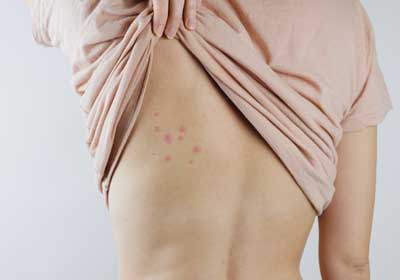Signs That You Have a Bed Bug Problem and Treatment Options
Ever woken up to mysterious, itchy bites that seem to have appeared out of thin air? It’s a scenario that many of us dread: the sneaky presence of bed bugs. These parasitic pests can turn a peaceful night’s sleep into a nightmare of discomfort and frustration. If you suspect you have bed bugs, read these tips to properly identify and treat an infestation.

How to Visually Look for Bed Bugs
The sooner you notice that you have bed bugs, the easier it will be to eliminate these pests. However, bed bugs are elusive insects that can be very difficult to spot, so it’s important to keep an eye out for early signs of an infestation. To see if you have bed bugs, look for:
- Spots on fabric or upholstery: While feeding, bed bugs will excrete small pellet-like droppings that resemble coffee grounds. These pets can also cause wounds on their hosts, leading to tiny red or black stains on fabric.
- Cast-off skins: As they grow, bed bugs molt several times and shed their skins, which end up scattered around their habitat. The molted skins are the same size and shape as a bed bug but are translucent or slightly whitish .
- Small eggs Bed bugs usually lay eggs near where they nest and feed. These eggs are whitish or translucent and look like a miniature grain of rice. Most are about 1 mm long with a small hinged cap on the front of the egg.
- Live bed bugs: Bed bugs have a tiny, flat, and oval-shaped body with six legs. They’re usually reddish brown or dark brown in color. While they usually measure up to 6 mm, their abdomens may appear more engorged after feeding.
Do You Have a Bed Bug Problem? We Can Help.
Click the button below to leave your information & we'll be in touch in an hour or less.
Pests Belong Outside!
Leave your information below and we will give you a call back.
"*" indicates required fields
*During normal business hours. After hours inquiries will be returned the next business day.
Where Do Bed Bugs Hide?
Bed bugs are only about the size of an apple seed, which makes it hard to spot the insects even when they’re out in the open. However, these pests are also notorious for hiding in hard-to-reach spots. Knowing where to look for signs of an infestation is just as important as knowing what a bed bug looks like. Some of the most common places that bed bugs hide include:
- In the seams or corners of bedding
- Inside of box springs or headboards
- Underneath loose wallpaper
- Behind artwork hung on walls
- In electrical outlets and appliances
- In the corners between walls or ceilings
- Inside dressers or drawers
- On sofas, chairs, and ottomans
- Inside of light fixtures, like lamps
What NOT to Do If You Have Bed Bugs
- Do not start sleeping in a different room: Bed bugs are creepy, so it’s understandable why you would want to switch bedrooms or sleep on the couch after discovering these pests in your room. However, sleeping in a different room makes it easier for bed bugs to spread throughout your house, which will make it more challenging to eliminate the infestation.
- Do not temporarily move out: Similarly, many people are tempted to sleep in a hotel or at a friend’s place to get away from bed bugs. Doing so puts the people around you at risk of experiencing an infestation as well. Bed bugs can survive for up to a year without feeding, so it may not be immediately obvious if you’ve accidentally carried the infestation to another property.
- Do not move items out of your home: While it may seem like a good idea to throw away infested items, this could make the problem much worse. As you carry the infested items through your home, bed bugs could fall off and invade new parts of your home. Moving a bunch of items could also prompt the bed bugs to scatter, making it even more difficult to treat the infestation.
- Do not use pesticides or DIY fumigation: Without professional assistance, pesticides or DIY fumigation could be dangerous and ineffective. Bed bugs are extremely adaptable, and the improper use of pesticides will do little to battle an infestation. Instead, it could cause harm to you, your family, or your pets.
How to Get Rid of Bed Bugs
It may be counterintuitive, but the best first step to treating a bed bug infestation is continuing to live as normal. Taking drastic action could just make the problem worse. Instead of attempting a DIY treatment, call a licensed exterminator like those at Batzner Pest Control. They have the tools and expertise needed to strategically eliminate the infestation and keep it from coming back.
Want to get rid of bed bugs as quickly as possible? Call us today to get started.
Signs That You Have a Bed Bug Problem and Treatment Options in Wisconsin
Serving Wisconsin
New Berlin | Oshkosh | Milwaukee | Kenosha | Madison | Racine | Appleton | Fond du Lac | Sheboygan
Cedarburg | Green Bay | La Crosse | Eau Claire | Baraboo | Wisconsin Dells | Wisconsin Rapids | Mauston | Viroqua | Chippewa Falls
Home » Bed Bug Learning Center » Bed Bug Identification » Signs That You Have a Bed Bug Problem and Treatment Options
